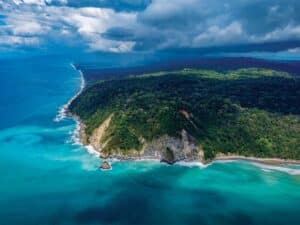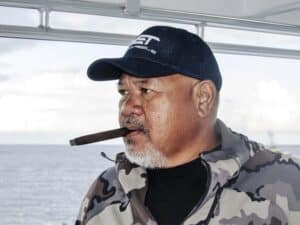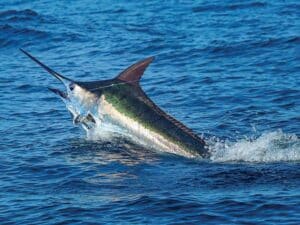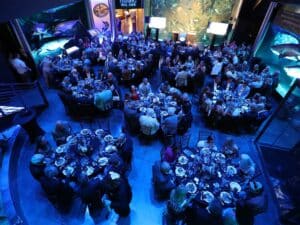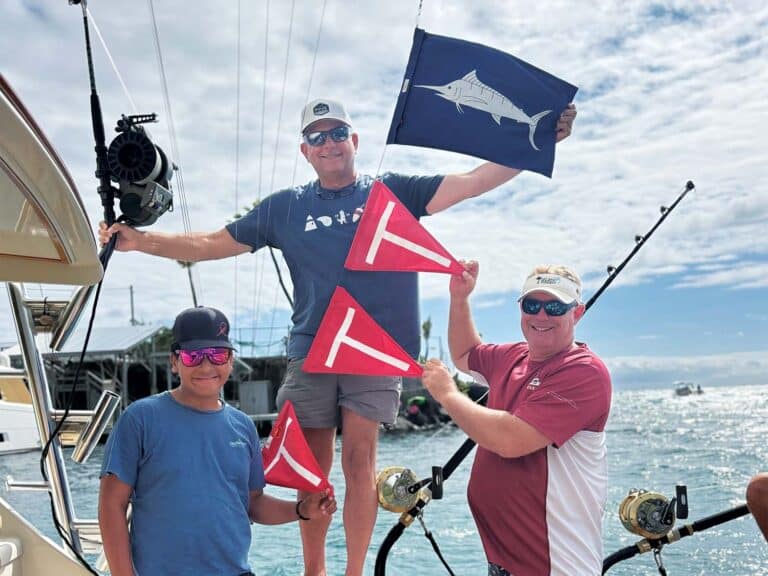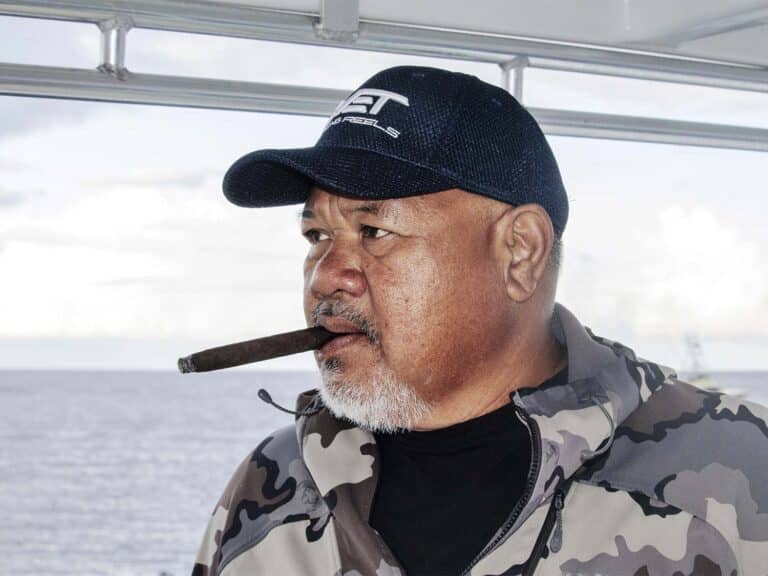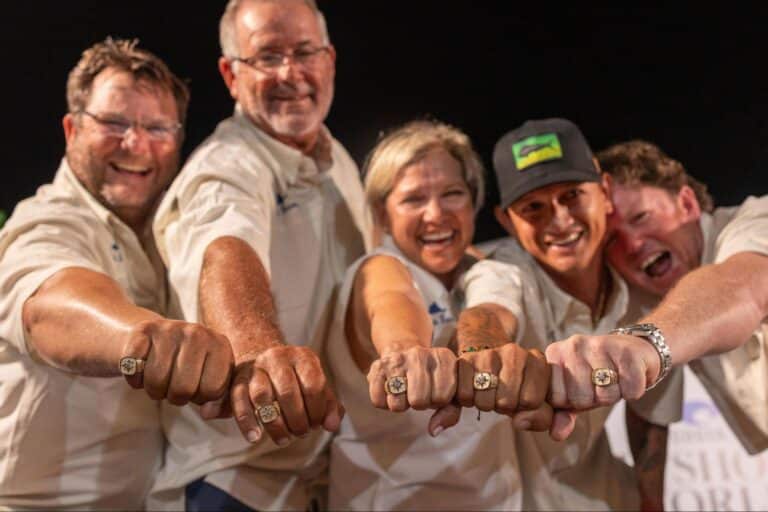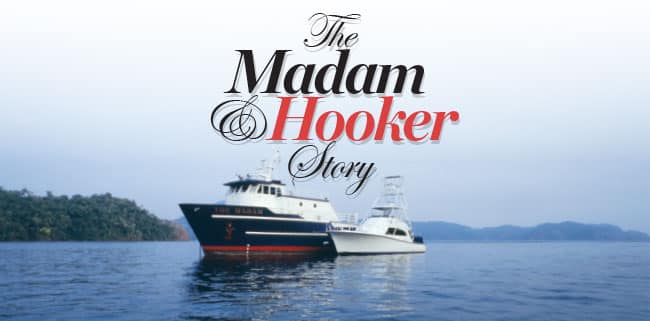
Courtesy of Madam & Hooker
Boat owners don’t often throw a party just for their crew, but on March 31, 2012, that’s exactly what Jerry and Deborah Dunaway did to mark the 25th anniversary of the launch of the globe-trolling Madam & Hooker mothership/game-boat operation that set more than 80 world records over more than two decades. The Dunaways, who owned the Hooker operation from 1979 until 1999, held the reunion to “recognize the people that made our success possible,” Jerry Dunaway says. The event took place at the International Game Fish Association Hall of Fame, in Dania, Florida, and longtime captains Skip Smith and Trevor Cockle served as its emcees.
Its roster of captains and deckhands read like a who’s who of fishing, with names like Skip Smith, Trevor Cockle, Jeff Fay, Mike Benitez, Randy Baker and Peter Wright, and mates Kent and Scott Levin, Curt Schloderer, Jody Bright, Eric Leech, Ronnie Fields, John and David Cochrane, Mitch Scherfer, Mike “Mikey D.” Deighan, the late Cyndy Smith, and Doug Haigh, just to name a few. One question begs asking: Was Madam & Hooker the most successful big-game fishing team ever assembled? Jerry Dunaway thinks so. “Without question, it was the most recognized and publicized fishing team in the world during the ’80s and ’90s,” Dunaway says. He holds up a thick bound compilation of magazine and newspaper articles covering their exploits, a book presented to each of the 25 or so mates and anglers who attended the gala.
“If you look at what my wife, Deborah, myself and our charter clients accomplished from 1980 until 1999, when we sold the boat, it makes a good case for us being the best,” Dunaway says. The team’s accomplishments include catching an amazing 81 IGFA world records, most of them billfish on light and ultralight tackle. Deborah is the only angler in history with a Royal Slam of world records for all nine billfish species; the Hooker team caught a Pacific quadruple grand slam, as well as the first documented women’s and men’s super grand slams, in 1981 and 1982; they caught 24 swordfish in 10 nights in 1986, with four of those being world records; and Capt. Trevor Cockle and guests, in 1997, caught 20 Atlantic blue marlin in a single day. Not only that, Dunaway says, but the Hooker team helped pioneer big-game fishing in many of the 23 countries it visited.
Equally as impressive, many of the 25-plus mates who started their careers on Hooker went on to become superstars in their own right. Guys like Capt. Ronnie Fields of Big Oh, whose career includes a Captain of the Year title, after working as a mate on Hooker in his early 20s, and Scott Levin, Randy Baker and Curt Schloderer, all of whom are excellent captains now.
The Beginning
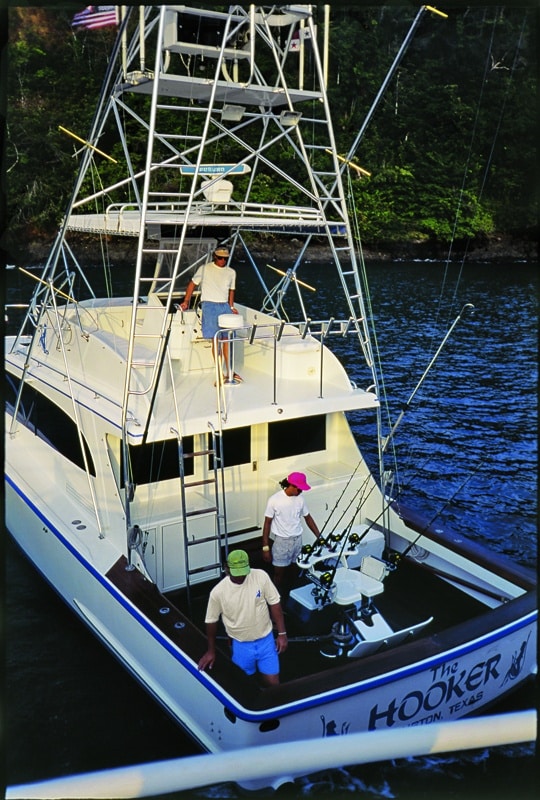
| |Whether Skip Smith or Trevor Cockle was at the helm, Hooker‘s line of excellent crewmen — that’s Randy Baker in the stylish pink hat — kept the world records coming. (Courtesy of Madam & Hooker)|
The story of the Madam & Hooker team begins in the early ’80s, when Jerry Dunaway, an intense, self-made Houston millionaire, set a goal to become an accomplished angler by traveling to the world’s best fishing spots. He hired a hungry Fort Lauderdale captain by the name of Frank “Skip” Smith, who was 25 when, in 1980, he went to work on Hooker as a mate, his brother Kent “Kunta” Smith having recommended him for the job.
Kent “Kunta” Smith first met Jerry Dunaway in Freeport, Texas, in 1980, where the Dunaways’ 53-foot Hatteras was moored. Kunta Smith was working the deck then for Capt. Eddie Herbert on Laurisa, when Dunaway stopped by to see if someone was available to mate for him on an overnight trip to the oil rigs. Kunta Smith agreed to do it, and for grins, he brought along a stiff-action 8-pound spinning rod. During a lull in the action the first night, the Florida mate dropped down and hooked a 30-pound-class crevalle jack, which he noted was about 1 pound shy of the world record. Dunaway became so intrigued with catching a world record that Kunta Smith offered him the rod. Soon Dunaway had a bigger fish on; it was only about a half pound off the record. “I’m pretty sure that fish gave Dunaway the idea to fish for world records,” Kunta Smith says.
In those days, Dunaway was still very green, having purchased his first big-game boat in 1979, a 53-foot Hatteras owned by REMCO, a nationwide rent-to-own appliance company started by Dunaway and his majority partner, Chuck Sims, in 1968. That Hatteras boat became the first of three fishing yachts called Hooker. Soon after, Dunaway invited Kunta Smith to join the crew of Hooker, working alongside Texans John Cochrane and Jerry’s original captain, Randy Parr, for planned trips to Cuba, the Bahamas and Belize.
After a few months and a tournament or two, Parr, who didn’t always see eye to eye with the boss, left the operation. Dunaway convinced Capt. Jeff Fay, with whom he had caught his first blue marlin in the ’70s, to take a leave of absence from his charter business in Kona, Hawaii, to man Hooker in Belize. “I’d always worked for myself,” Fay says. “Jerry is the only private guy I ever worked for.” Fay says that he agreed to do it because “Dunaway is a straight shooter. He does what he says he’ll do, so I had confidence it would be a great trip.”
To round out the crew, Kunta Smith contacted his brother Skip, who was working in commercial swordfishing off Florida, and he agreed to come aboard and mate. “That was the beginning of my seeing what can be accomplished with a professional fishing crew,” Dunaway says.
Skip Smith Takes the Wheel
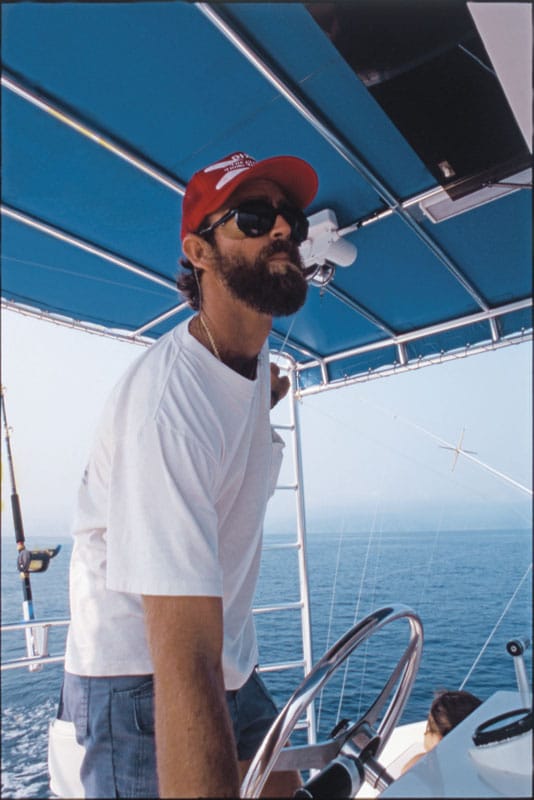
| |Frank “Skip” Smith (Courtesy of_ Madam & Hooker_)|
Belize is known more for grouper spawning events, active permit and bonefishing in the shallows than for blue-marlin action, but Team Hooker‘s success there — they caught 14 blues in three weeks — marked the first of the team’s many revelations. After finishing the tour in Cozumel, Fay left to fly back to Hawaii so that Skip Smith, the only crew member with a captain’s license, could take the wheel.
With a successful commercial swordfish operation under way in Florida with his mentor and friend Craig Koch, Smith was not really interested in taking a fishing job for the money, or to just go fishing for fishing’s sake. He was into exploring new techniques, little-known fishing grounds and doing things that had never been done before, all of which struck a chord with Jerry Dunaway, who convinced him to become his full-time captain. Within two years, they had caught the first documented billfish super grand slams at Cozumel (four species in one day), and were spending months at a time fishing remote places like Isla Coiba, off the Pacific coast of Panama, where Smith started working on their skills targeting fish on lighter lines.
In the years leading up to the launch of the custom 48-foot G&S Hooker, in 1985, and the mother boat Madam, in 1987, the foundation of the team’s success and approach to fishing took shape. Prior to this, on the 53-foot, and, later, a 65-foot, Hatteras, Team Hooker traveled and fished Texas, the Bahamas, Belize, Cuba, Cozumel, Panama and St. Thomas. Winning tournaments was the main priority in those years.
In 1980, Hooker‘s “Texas Terrors,” as Dunaway referred to his team, finished second in the money at Port O’Connor’s famous Poco Bueno Tournament, catching the largest blue marlin in the event. Jeff Fay was at the helm of a boat they chartered after leaving Hooker in Florida. Prior to Poco Bueno, they had finished second in the Hemingway Blue Marlin Tournament.
The following year, in the 1981 Poco Bueno Tournament, they netted $273,000 of the $573,000 jackpot with a first-place win, then the largest payday in big-game-fishing history. At the banquet, Dunaway credited his all-star roster of crewmen — Skip and Kunta Smith and, for this tournament only, Capt. Peter B. Wright — and a little-known soft-plastic trolling lure, with the win. That lure became known as the Hooker, and it went on to win five out of eight tournaments (placing second twice) the next year.
Frank Johnson of Mold Craft Fishing Products credits Peter B. Wright for giving him the idea for a soft big-game fishing lure in the 1970s, and says that the Hooker team did some of the early research and development on lure fishing, suggesting that he tweak the design of the bubble-making Wide Range lure by cutting the nose shorter. Johnson called the improved version the Hooker. “That was the beginning of a long collaboration between the Hooker team and Mold Craft,” Johnson says. “For us, it was great having them help develop and test our lures, because they fished harder than anyone back then.”
Mothership Dream
After selling REMCO and the company boat with it, in 1984, Jerry Dunaway started construction on a custom 48-foot G&S sport-fisherman that was delivered the next year. For the next 18 months, Hooker traveled on its own bottom to Venezuela, St. Thomas and Panama. “Ideally, we would have started fishing remote places then, but we were limited to destinations that had fuel and dockage,” Dunaway says.
During a cold-water event in February of 1986, while fishing off Piñas Bay, Panama, Smith spotted a swordfish tailing on the surface, which led to 10 days of the most spectacular fishing he’d ever encountered. Smith suggested that they go out at night and try for one on light tackle. The Dunaways ended up setting not one but four records over the next few days, including Deborah’s 12- and 16-pound women’s records and Jerry’s still-standing 8- and 12-pound men’s swordfish records. Those 24 fish in 10 days identified a fishery that Piñas Bay’s Tropic Star Lodge had no idea was there.
While still at Piñas Bay, in 1986, Californian Jim Jenks arrived with his mothership Ocean Pacific, and invited Dunaway and Smith for dinner and a tour. “That set me on the path of building a mothership operation that could travel and fish the world,” Dunaway says.
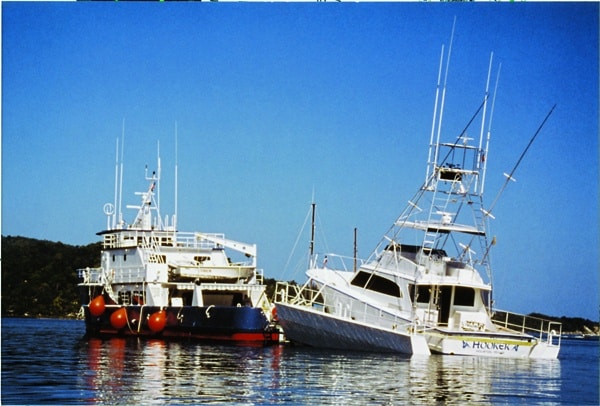
| |Madam & Hooker was one of the first globe-trotting sport-fishing operations to use a cradle to carry the game boat. (Courtesy of Madam & Hooker)|
After months of looking for a suitable mothership, Dunaway found the perfect vessel in his own backyard of Freeport, Texas. Purchased for $100,000, the 110-foot oil-supply boat underwent an eight-month, $1.2 million refit and began its history-making adventure on Jan. 1, 1987. With Smith, newly hired mate Trevor Cockle of Kona, Hawaii, engineer and second mate John Cochrane and his wife, Anne Marie, the hostess and cook, Hooker had its first four-member crew.
The first stop was Piñas Bay, Panama, where, two weeks later, Deborah Maddux Dunaway caught the still-standing women’s record: a 239-pound black marlin on 8-pound-test line. It was an auspicious start for the world-record tour.
Both Smith and Cockle, who took over the fishing operation in 1991 when Smith left, say that without the durable 48-foot G&S game boat, built for turning and backing on record fish and long oceanic crossings, they would not have accomplished what they did. Cockle, who spent some 20 years or so fishing on Hooker, calls it “the baddest fishing boat of all time.” She was built to survive running countless hours wide open in reverse, he explains, and was towed thousands of miles around the world. Cockle says that she’s as sound today as the day she was built.
Cockle recalls the day that workers at Miller Marine, in Panama City, Florida, dug 28 bills from the hull. “I’m guessing that’s got to be another record,” Cockle says. Back then, the boat was powered by a pair of Cummins M903VTA engines painted pink, and jacked up with 2-inch shafts to accommodate faster gearshifts when chasing fish. Still, top speed was a subdued 30 knots. What made her everyone’s favorite was the ride, balance and maneuverability provided by sensitive Panish controls and by Smith having the engines mounted beam to beam. “Every little bit helps turning sideways on a fish at top speed,” says the 57-year-old captain, who now heads Smith-Merritt Insurance, in Pompano Beach, Florida.
The Bait-and-Switch
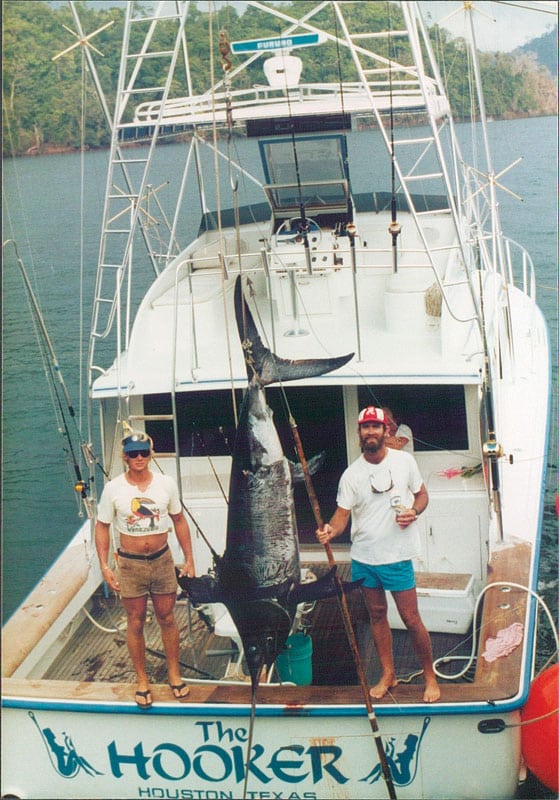
| |Capt. Skip Smith|
The G&S provided the platform on which Smith perfected the bait-and-switch techniques now practiced worldwide. For those who wonder how and where it started, Smith credits Capt. Ron Hamlin for telling him how to go about fulfilling Dunaway’s goal of filling the newly created 2-, 4-, 6-, 8-, 12- and 16-pound billfish world records.
“Fishing two anglers like we were with Jerry and Deborah, bait-and-switch was a solution to the larger issue of how to select the right rod and line class for the right size fish,” Smith says. “The idea came to me in the early 1980s on the North Drop in St. Thomas while watching Hamlin trying to catch blue marlin on fly. He trolled with one rigger up, pulling a short bridge teaser and a hookless lure/mackerel from a rod in the covering boards that they used to tease fish in close so that Jim Lopez could make a fly cast. I thought, Why not fish two hookless teasers from the bridge and two hookless softhead lures as teasers long from rods in the covering boards?”
Working with the late Scotty Boyd of Boyd’s Tackle in Fort Lauderdale, they came up with a setup that utilized the usual bridge teasers, plus a new teaser rod-and-reel setup using a 50-wide with 300-pound mono on a short custom rod. Despite its popularity today, the bait-and-switch didn’t take off right away, Smith says. “Stewart Campbell was a brilliant angler, but well into the late ’80s, he was still pulling lures with hooks from the outrigger pins trying to catch 30- and 16-pound Atlantic blue-marlin records, instead of baiting them with hookless lures and switching to bait like we were. No one was switch fishing back then but us. We were so confident in it that we pitch-baited during a tournament way back in 1988 and in 1992. Trevor was the first to do it in the Bisbee’s Black & Blue Tournament at Cabo San Lucas,” Smith says.
Smith understands why captains saw pitch-baiting as labor intensive. It requires 100 percent attention to detail. It’s not the kind of fishing suited to salon anglers, which explains why, in 2004, Skip Smith was surprised by what he saw walking down the docks at Red Hook in St. Thomas. “I was used to seeing 80 wides and 130s in the covering boards, not rod holders filled with teaser rods and 30- and 50-pound outfits with hookless lures on the tips. Going from a time when no one but us was doing it to seeing the acceptance of pitch-baiting in a prestige tournament like the Boy Scout at St. Thomas surprised the heck out of me.”
As it turns out, the biggest challenge Smith faced in developing ultralight billfishing techniques in the 1980s was settling on the right rod design. “We seemed to break the line a lot while fighting fish,” he says. “A lot of research and development went on between me and Scotty Boyd, who was a big part of our success.”
The breakthrough came during that Piñas Bay trip in 1986, when Frenchmen Marc Giraud and Jean Paul Richard came aboard to catch a swordfish, Smith says. “Marc had caught a lot of big fish on 2-, 4- and 8-pound tackle. Watching him fish under certain conditions was an education — since he seldom broke a line. I noticed that he was using a lot more guides and a longer rod than we were.”
Following some trial and error with the longer rods, Smith determined that the long rods were not the answer, because it was too hard for the mate to grab the leader. “We settled on 6-foot rods with 12 to 14 guides. The guides evened out the pressure and friction on fragile light lines, and the shorter rod length made it easier to grab the leader,” Smith says.
The other secret of their success came in the form of the new Shimano TLD25 reels. “The lever-drag and smooth systems were superior to the star drags on other big-game reels of the day. And because they were so much lighter, it was easier on the angler during long fights. We always used the TLDs with harness lugs so that we could put a shoulder harness on the angler,” Smith says.
Records Start to Fall
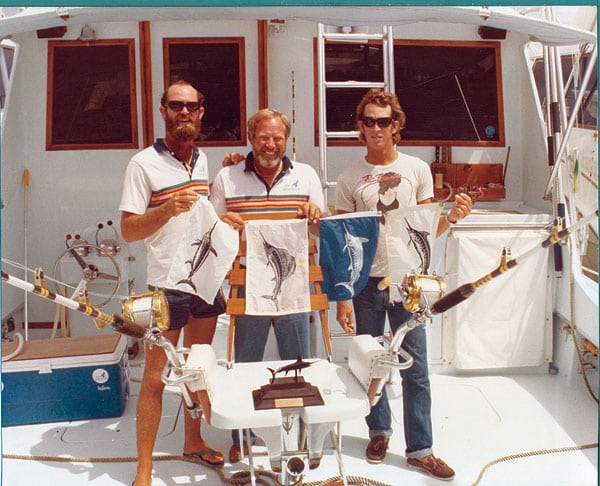
| |Capt. Skip Smith|
Some records have stood the test of time, but many of the first records that the Hooker crews set lasted only a week before they were broken — either by the Dunaways or anglers and guests like Mark Giraud, Dick and Marge Love, or Stewart Campbell on Chunda. “There weren’t too many fishing for light-tackle billfish records then, but the ones that did were very competitive,” observes Capt. Scott Levin, who was hired straight out of college, in 1988, to replace Trevor Cockle during his 16-month break from the boat.
Full of enthusiasm but somewhat lacking in experience, Levin was just the kind of mate Smith preferred. “Trevor probably will agree that, when hiring mates, their personality, work ethic and enthusiasm are more important than experience. Because our fishing style was so different, I wanted mates that were teachable,” Smith says.
Living and working in close quarters 24/7 for months on end, you need someone who loves to fish and is fun to be around, Smith adds, which is exactly why guys like Capt. Mike Deighan, Kunta Smith and Curt Schloderer were such a good fit.
Madam & _Hooker _****Team Member Roster
- Frank “Skip” Smith (Operation Captain)
- Trevor Cockle (Operation Captain)
- Kent “Kunta” Smith (Hooker Mate)
- Cyndy Smith (Mate)
- John Cochrane (Mate & Engineer)
- Ann Marie Cochrane (Madam Hostess/Chef)
- Randy Baker (Hooker Mate & Captain)
- Tami Baker (Madam Hostess/Chef)
- David Cochrane (Mate)
- Peter B. Wright (Captain)
- Jerry Parson (Madam Engineer)
- Barbara Parson (Madam Hostess/Chef)
- Chester Jenkins (Hooker Mate)
- Scott Levin (Hooker Mate)
- Buddy Hill (Hooker Mate)
- Ronnie Fields (Hooker Mate)
- Eric Leech (Hooker Mate)
- Jeff Fay (Hooker Captain)
- Mitch Scherfer (Hooker Mate)
- Curt Schloderer (Hooker Mate)
- Greg Mercurio (Hooker Mate)
